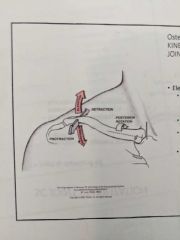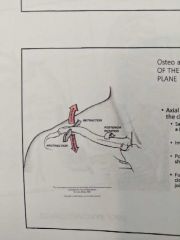![]()
![]()
![]()
Use LEFT and RIGHT arrow keys to navigate between flashcards;
Use UP and DOWN arrow keys to flip the card;
H to show hint;
A reads text to speech;
94 Cards in this Set
- Front
- Back
|
Three parts of the shoulder |
Humerus, clavicle, scapula |
|
|
Costal tuberosity provides an attachment for what? What bone is it located on? |
Costoclavicular ligament Clavicle |
|
|
Which part of the clavicle articulates with the scapula? |
Acromial facet |
|
|
What two landmarks mark the interior surface of the lateral end of the clavicle? |
Conoid tubercle Trapezoid line |
|
|
Three angles of the scapula |
Superior Inferior Lateral |
|
|
Borders of the scapula |
Medial/vertebral Superior Lateral/axillary |
|
|
Supraspinatus fossa |
Shallow indentation superior to the spine of the scapula. |
|
|
Infraspinatus fossa |
Shallow indentation inferior to the spine of the scapula posterior side |
|
|
Spine of scapula location |
Posterior side, splits posterior into the two fossas |
|
|
Root of the spine of the scapula |
Medial end of root, relatively flat compared to the rest of the spine |
|
|
Acromion process |
Lateral end of spine; broad and prominent, extends in a lateral and anterior direction forming horizontal shelf over glenoid fossa |
|
|
Clavicular facet of scapula |
Part of the acromiom, articulates with the clavicle. Forms AC |
|
|
Supraglenoid tubercle |
Located over the superior rim of the glenoid fossa. Attachment for biceps |
|
|
infraglenoid tubercle |
Located at the inferior rim of the glenoid fossa. Attachment for triceps |
|
|
Coracoid process |
Near superior rim of glenoid fossa |
|
|
The humeral head faces medially and superiorly, forms an approximate ____ degree angle of _______ with the shaft of the humerus |
135 Inclination |
|
|
Crest of the humerus |
Bony prominences which surround the anterior and lateral circumference of the proximal humerus |
|
|
Lesser tubercle of humerus. Location? Attachment for which muscle? |
Projects sharply for subscapularis attachment |
|
|
Greater tubercle of humerus |
Large and rounded- more lateral |
|
|
Intertubercular (bicipital) groove of humerus |
Between the crests |
|
|
Deltoid tuberosity of humerus |
Distal and lateral to the termination of the groove |
|
|
Radial (spiral) groove of humerus |
Run obliquely across the posterior surface |
|
|
Four joints of the shoulder |
Glenohumeral Sternoclavicular Acromioclavicular Scapulothoracic (AC & SC) |
|
|
Difference between shoulder complex and shoulder girdle |
Complex: all joints Girdle: Scapulothoracic joint (AC & SC) |
|
|
Movement of the GH joint ALWAYS requires _______ movement |
Scapular |
|
|
Some scapular movement, such as ______, always involves GH movement |
Rotation |
|
|
Scapular motion during elevation |
Scapula slide Superior on thorax |
|
|
depression Scapulothoracic joint |
From an elevated position the scapula slides inferiorly |
|
|
Protraction (scapular abduction) Scapulothoracic joint |
Medial border of scapula slides anterior-laterally on the thorax away from midline |
|
|
Retraction (scapular adduction) Scapulothoracic joint |
Medial border of the scapula slides posterior-medially on the thorax toward midline (pinch scapula together) |
|
|
Upward rotation Scapulothoracic joint |
Inferior angle of scapula rotates in the superior-lateral direction (occurs when arm moves overhead) |
|
|
Downward rotation Scapulothoracic joint |
Inferior angle of the scapula rotates in an inferior-medial direction such that the glenoid fossa faces downward (arm adduction) |
|
|
The sternoclavicular joint function |
Acts as a prop to maintain scapula at a relatively fixed distance from the trunk |
|
|
SC joint is the basilar joint. What does this mean? |
It links the appendicular skeleton to the axial skeleton |
|
|
SC joint is what kind of joint? |
Saddle |
|
|
Medial clavicle is _____ along it's longitudinal diameter and _____ along it's transverse diameter |
Convex Concave |
|
|
The clavicular facet of the sternum is ______ longitudinally and _____ transversely |
Concave Convex |
|
|
Ligament that connects the clavicles |
Intraclavicular ligament (spans jugular notch) |
|
|
SC joint is stabilized by what three ligaments |
Anterior and posterior sternoclavicular ligaments Costoclavicular ligament |
|

What happens during elevation at the SC joint? Roll/slide. What plane? |
Convex head rolls superiorly and slides inferiorly on concave sternum Frontal plane |
|

What happens during depression at the SC joint? Roll/slide. What plane? |
Head rolls inferiorly and slides superiorly Frontal |
|

What happens during protraction at the SC joint? Roll/slide. What plane? |
Concave articular surface of clavicle rolls and slides anteriorly Transverse plane |
|
|
What happens during retraction at the SC joint? Roll/slide. What plane? |
Concave articular of clavicle rolls and slides posteriorly on the convex surface of sternum Transverse plane |
|
|
At the SC joint there is about ____ degrees of elevation and ____ degrees of depression |
45 10 |
|
|
At the SC joint there is about ____-____ degrees of motion for retraction and protraction |
15-30 |
|
|
What happens during axial (posterior) rotation at the SC joint? What plane? |
Involves spin Sagittal plane Posterior spin happens with shoulder flexion/extension |
|
|
Arthrokinematics can be described at which joints of the shoulder |
GH & SC. Not AC |
|
|
Ligaments that support the AC joint |
Superior and inferior acromioclavicular ligaments Coraclavicular ligaments -trapezoid -conoid |
|
|
Two coraclavicular ligaments of AC |
Trapezoid and conoid |
|
|
Two muscles that stabilize AC joint |
Deltoid and upper trap |
|
|
AC is what kind of joint |
Plane joint. Relatively flat surfaces |
|
|
Motions of the scapula at the AC joint |
Upward and downward rotation Sagittal plane adjustment (tilting) Horizontal plane adjustment (IR/ER) |
|
|
Motions at SC joint |
Elevation/depression (frontal) Protraction/retraction (transverse) Posterior spin (sagittal) |
|
|
Complete upward rotation of scapula at the AC joint is considered the ______ position |
Close packed |
|
|
Except for fine tuning movements, the scapula must follow.... |
The clavicle absolutely |
|
|
Regarding Scapulothoracic joint, the SC joint is movement where? |
Clavicle |
|
|
Regarding Scapulothoracic joint, the AC joint is movement where? |
Scapula |
|
|
Scapulothoracic protraction at the AC and SC joints? |
AC- internal rotation SC- protraction |
|
|
Scapulothoracic retraction at AC and SC joints? |
AC- ER SC- retraction |
|
|
Scapulothoracic depression at AC and SC joints? |
AC- upward rotationSC- depression |
|
|
Scapulothoracic elevation at AC and SC joints? |
AC- downward rotationSC- elevation |
|
|
Scapulothoracic downward rotation at AC and SC joints? |
AC- downward rotationSC- depression |
|
|
Scapulothoracic upward rotation at AC and SC joints? |
AC- upward rotationSC- elevation |
|
|
What is each joints responsibility for reaching 180* abduction at the shoulder? |
GH- 120* AC- 30* SC-30* |
|
|
GH joint surrounded by what? |
Fibrous capsule |
|
|
Potential volume of space within the GH joint capsule is ____ the size of the humeral head. |
Twice |
|
|
Muscles that stabilize GH joint |
RTC Long head of biceps |
|
|
Ligaments and other tissue that stabilize GH joint |
GH joint capsular ligaments Coracohumeral ligament Glenoid labrum |
|
|
Glenoid labrum description |
Fibrocartilage ring or lip which encircles the glenoid fossa- helps increase depth by about 50% |
|
|
Superior glenohumeral ligament attachment |
Proximal- near the supraglenoid tubercle just anterior to long head of biceps |
|
|
Superior glenohumeral ligament function |
Provides restraint inferior and anterior-posterior translations of the humeral head WHEN taut in adduction |
|
|
Middle glenohumeral attachment |
Proximal: Superior and middle aspects of the anterior lip of the glenoid fossa |
|
|
Middle glenohumeral function |
Provides substantial anterior restraint Becomes tight with ER |
|
|
Inferior glenohumeral ligament attachment |
Proximal: along anterior-inferior rim of glenoid fossa Distal: attaches to anterior-inferior margins of anatomical neck |
|
|
Inferior glenohumeral ligament three components |
Anterior Posterior Axillary pouch |
|
|
What forms the coracoacromial arch |
Coracoacromial ligament and acromiom process |
|
|
Coracoacromial ligament attachments |
Between anterior margin of acromiom and lateral border of coracoid process |
|
|
Only about ___ cm of distance separates the undersurface of the coracoacromial arch and the humeral head |
One |
|
|
What is in the subacromial space |
Tendons and capsule |
|
|
Coracohumeral ligament attachment |
Runs from lateral border of coracoid process to anterior side of the greater tubercle of humerus
Becomes tight with extremes of ER, flexion, and extension |
|
|
How many bursa in the shoulder? |
8 |
|
|
Two most important bursa |
Subacromial and subdeltoid |
|
|
Static stability of GH joint is provided by what? 3 factors |
Supraspinatus and posterior deltoid Inclined plane of glenoid fossa Negative pressure within GH joint |
|
|
Humeral head would hit coracoacromial arch at ___ degrees of it could not slide |
22 |
|
|
Proper shoulder movement and full ROM of the shoulder complex requires... |
GH abduction and scapular upward rotation |
|
|
6 kinematic principles for full shoulder abduction |
1) upward rotation of scapula 2) elevation at SC and ^ rotation of scapula at AC 3) clavicle retracts at SC joint 4) scapula posteriorly tilts and ER 5) clavicle rotates posteriorly 6) GH externally rotates |
|
|
First kinematic principle full shoulder abduction: scapula must ____ rotate. Purpose? |
Upwardly Projects glenoid fossa upward and anterior-laterally. Preserves optimal active length tension Helps maintain volume within subacromial space |
|
|
Second kinematic principle full shoulder abduction: clavicle at SC joint must _____ and scapula at AC joint must ______. |
Elevate Upward rotation |
|
|
Third kinematic principle full shoulder abduction: clavicle _____ at the AC joint. Purpose |
Retracts Assists AC joint with optimal positioning of the scapula within the horizontal plane |
|
|
Fourth kinematic principle full shoulder abduction: scapula _______ and _______. Purpose? |
Posteriorly tilts and externally rotates Primarily at the AC joint- necessary to move the coracoacromial arch away from the advancing humeral head |
|
|
Fifth kinematic principle full shoulder abduction: clavicle ______ _______. |
Rotates posteriorly |
|
|
Sixth kinematic principle full shoulder abduction: GH joint _______ |
Externally rotates |
|
|
Subluxation |
Partial separation of humeral head and glenoid fossa |
|
|
Three types of shoulder instability |
Post traumatic Atraumatic Acquired instability |

